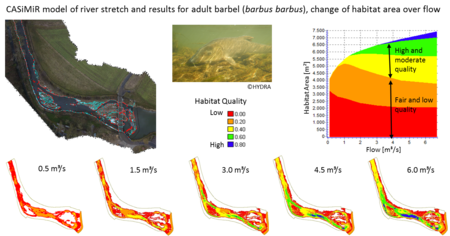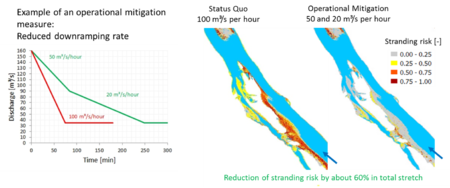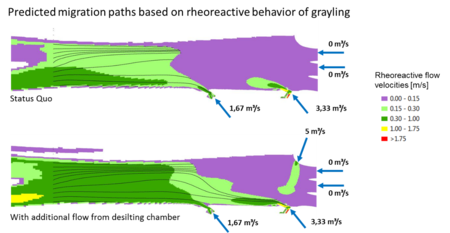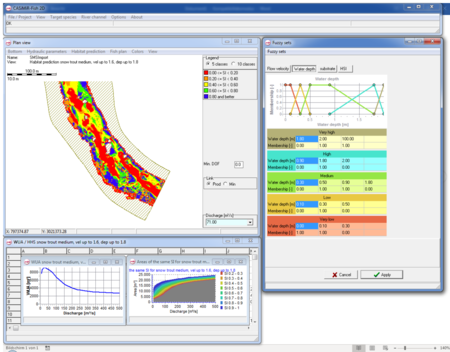HEC-RAS
Contents
Quick summary
Developed by: CEIWR-HEC, the Hydrologic Engineering Center an organization of the United States Corps of Engineers (USACE) Institute for Water Resources
Date:
Type: Tool
Suitable for the following [[::Category:Measures|measures]]:
Introduction
HEC-RAS (Hydrologic Engineering Center-River Analysis System) is a freely available and widely used software tool for open channel flow analysis. The first version of the software, originally developed as a one-dimensional (1D) open channel flow analysis tool, was released in July 1995. In 2016 the ability to perform two-dimensional (2D) modelling was added. The current version allows users to perform 1D steady flow and 1D/2D unsteady flow modelling, sediment transport/mobile bed computations, and water temperature/water quality modelling for a full network of natural and constructed channels, or a single river reach, under the same graphical user interface (GUI) (Figure 1).
The basic computational procedure of HEC-RAS for steady flow is based on the solution of the 1D energy equation, the energy losses are evaluated by friction (Manning’s equation) and contraction/expansion (coefficient multiplied by the change in velocity head). The momentum equation may be used in situations where the water surface is rapidly varied (e.g. hydraulic jumps, bridges, river confluences). For the 1D unsteady flow computation, HEC-RAS solves the full, dynamic, 1D Saint Venant Equation using an implicit finite difference method. For the 2D modelling the software solves either the 2D Saint Venant equations, often referred to as the shallow water equations (with optional momentum additions for turbulence and Coriolis effects) or the 2D Diffusion Wave equations. This is user-selectable, giving modellers more flexibility. The shallow water equations solver disregards vertical velocities and assumes hydrostatic pressure, whereas the diffusive wave approximation solver additionally omits unsteady, advection and turbulent viscous terms, which narrows the range of applicability but has many computational advantages. Thus, in general, selection of the 2D Diffusion Wave equations allows the software to run faster, and has greater stability properties, whereas the 2D Saint-Venant equations are applicable to a wider range of problems. The 2D unsteady flow equations solver uses an Implicit Finite Volume algorithm. The implicit solution algorithm allows for larger computational time steps than explicit methods. The Finite Volume method guarantees improved stability and robustness over traditional finite difference and finite element techniques with the wetting and drying of 2D cells being very robust.
The 1D and 2D solution algorithms are tightly coupled on a time step basis with an option to iterate between 1D and 2D flow transfers within a time step. This allows for direct feedback at each time step between the 1D and 2D flow elements.
The 2D modelling has a flexible mesh generation allowing the user to generate a computation grid that is a mixture of structured and unstructured mesh types with the possibility of containing a mixture of cell shapes (the model is limited to elements with up to eight sides) and sizes. A user can customize a mesh to suit the terrain, containing predominantly large orthogonal grid cells (which simplifies the numerical discretization, making it more efficient), and where needed smaller cells, orientated appropriately along controlling terrain such as road crests, or along important river channels.
Within HEC-RAS each computational cell and cell face is based on the details of the underlying terrain, which is referred to as “high resolution subgrid model”. This allows larger cell sizes without compromising the resolution of the results, since it still accurately represents the underlying terrain, with gains in the modelling time.
Application
CASiMiR integrates interfaces for several 2D hydrodynamic models such as Hydro-AS_2D, SRH, BASEMENT, FLUMEN, River2D. The model has been applied in rivers of most different dimensions, types and stretches with lengths between several 10 meters to sections of several dozens of kilometres length (Figure 4).
CASiMiR is unique in that it makes use of physical and biological parameters through the application of expert knowledge using fuzzy logic-based rule systems, but can also use the standard preference function method as well. The main advantages of using habitat simulation models are:
- The ecological condition of an aquatic ecosystem is directly coupled with the living conditions of the typical resident species.
- The use of habitat models allows for the effects of changing flow rates and structural characteristics to be account for and can be used to predict their impacts.
- Changes to the flow rate and morphology result primarily in impacting the water depth, flow velocity, and substrate conditions, all of which are major factors in determining the habitat suitability and can be directly evaluated with numerical models.
- Due to the direct relationship between habitat conditions and flow rate, a quantitative basis can be established whereby an overall ecological assessment of the habitat requirements can be performed.
Other information
Base versions of CASiMiR are free for download under http://www.casimir-software.de. Advanced versions can be purchased via mailbox@sjeweb.de. Scientific and commercial licenses are available.
Relevant literature
- Noack, M., Schneider, M. and Wieprecht, S. (2013): The Habitat Modelling System CASiMiR: A Multivariate Fuzzy Approach and its Applications; in Ecohydraulics: An Integrated Approach, Chapter 6 (75-93); Editors I. Maddock, A. Harby, P. Kemp, P. Wood, John Wiley & Sons Ltd
- Schneider, M., Kopecki, I., Tuhtan, J., Sauterleute, J., Zinke, P., Bakken, T., Zakowski, T., Merigoux, S. (2016): A Fuzzy Rule-based Model for the Assessment of Macrobenthic Habitats under Hydropeaking Impact. River Research and Applications, 1467-1535
- Kopecki, I., Tuhtan, J., Schneider, M., Ortlepp, J., Thonhauser, S., Schletterer, M. (2014): Assessing Fishway Attraction Flows Using an Ethohyraulic Approach. 3rd IAHR Europe Congress, Porto, April 14-16.



